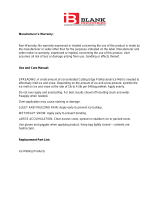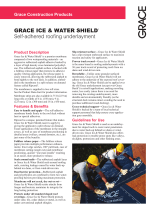Page is loading ...

70
1/12
SNOW RETENTION SYSTEMS
Snow Retention Systems
fax 717.299.2194 phone 800.347.2586 AmerimaxHP.com
M A D E I N U S A
Description
Pack
Qty.
Available Colors and Part Numbers
Part Number Available Colors/Materials
Mini Snow Guard Plastic
100 85040 Clear Plastic
Mini CLear Snow Guards are manufactured in a high clarity polycarbonate plastic with U.V. stabilizers which provide
strength and longevity. These are designed to fit between the stiffening ribs of residential metal roof panels. They
have a low visibility and blend with roof materials. They can be attached with adhesives, screws or a combination
of both. Not for use with panels with seams or ribs more than 12 inches apart.
SB-190 Surebond Everseal
24 SB-190 -
SB-190 is a field proven sealant adhesive. This unique formula possesses up to 2000 lbs. of tensile strength, but
requires 28 consecutive days (672 consecutive hours) with temperatures of 50 degrees Fahrenheit or greater to fully
cure. Under certain conditions, temporary measures may need to be employed to hold the snow guard in place until
initial set of adhesive has taken place. One tube will adhere 8-10 CL Snow Guards and 14-16 RTMINI Guards.
The adhesives are offered for the convenience of the user who assumes full responsibility for its use. These adhesives
are used throughout the industry for adhering snow guards with successful results utilizing the directions of the
adhesive manufacturer. Adhesive failure does not constitute Amerimax products defect and is not the responsibility
of Amerimax.
Snow Guards for Metal Roofs
Typical Spacing
for Metal Roong
See page A7 in the Appendix for information on snow guard installation and warranty.
Typical spacing for shingle, slate, synthetic slate, tile and shake roong
Horizontal spacing will be dictated but how far apart the metal seams or ribs. Shown is a typical RTMINI
application on a 9" or 12" center rib panel. Do not place Snow Guards beyond the bearing wall on an extended
roof section. Please see Appendix page A7 for general installation information.

a7
1/12
aPPENdIX
Appendix
fax 717.299.2194 phone 800.347.2586 AmerimaxHP.com
M A D E I N U S A
Snow Guard Technical
THIS DOCUMENT CONTAINS IMPORTANT SAFETy, WARRANTy AND PRODUCT INFORMATION –
READ IT CAREFULLy!
RETAIL SNOW GUARD INSTALLATION GUIDELINES
The purpose of a Snow Guard is to help reduce a slide, not stop it. Snow Guards are intended to reduce the potential for snow and ice
damage to gutters, foundation plantings, parked vehicles, adjacent roofs and equipment, and injury to pedestrians. Snow Guards are
attached to the roof structure in order to uniformly retain and hold snow in place on the roof area. The Snow Guards need to be applied
in sufficient quantity and according to a prescribed pattern in order to be effective. Snow Guards are intended to prevent snow movement
and provide for the controlled melt and breakdown of the snow mass into smaller sections.
Snow Guard placement will vary from region to region and will be influenced by roof pitch, the lengths of roof runs and roof features.
Placement should be determined by a qualified professional. Placement recommendations can be found in Sheet Metal and Air
Conditioning Contractor's National Association (SMACNA) Architectural Sheet Metal Manual and other industry standards. The best
practice with any installation is to develop a layout aimed at retaining the snow in place rather than trying to stop it at the eaves after it has
begun to slide. This principal is particularly important where adhesive mounted devices are to be used. Always consult building codes,
architects and/or engineers when roof pitch exceeds 12:12.
A qualified roofing contractor should be employed to install these products. Roofing professionals have the proper equipment, knowledge
and ability to complete the task in a safe and satisfactory manner. The installer is responsible for compliance with all governing building
and safety regulations. Prior to application, the installer should evaluate all products in order to determine fitness for use.
Positioning of Berger snow guards required for effective use:
The best positioning will vary depending on the particular roof. In general, snow guards should be placed 1 every 40 inches over entire
roof or in 2 groups of 3 staggered rows on 30 inch centers with 1 group at the eave and 1 group midway on roof slope. On long slopes,
multiple groups with 6 ft. space separation maximum.
• Do not place Snow Guards beyond the bearing wall on an extended roof section. This can result in ice damming and structural damage
to the roof.
• Do not use Snow Guards on low-slope roofs (those with pitches less than 3:12). Snow guards help reduce the momentum of a potential
snow slide. On low-slope roofs, snow does not typically slide off in the same manner. Under these circumstances, it is often better to
allow the snow to naturally clear itself from the roof as quickly as possible or to manually remove it. Therefore, snow guards are not
recommended for low-slope roof applications. Check with the roof manufacturer for specific product application limits and, as always,
observe all roof safety guidelines.
• Always check metal roofing warranty before mechanically fastening snow guards. Use of mechanically through fastened snow guards on
metal roofing may void metal roofing manufacturer’s watertight warranty.
• Do not use competing, or dissimilar metals. Galvanic corrosion will occur when dissimilar metals are in contact in the presence of an
electrolyte. Water in the form of condensation, rain or snow is an electrolyte. Water that flows over copper becomes electronegative
and will cause corrosion of aluminum or steel. Copper, brass or stainless steel fasteners or nails must be used with copper or brass
applications. Make sure rivets are solid copper; do not use copper plated steel rivets in copper or brass assembly. Do not use aluminum
or galvanized nails to secure any copper products.
Corrosion will be more rapid in the presence of salts such as ocean coastal areas or chlorinated water, acid rain, and polluted industrial
atmospheres. Accelerated corrosion will occur when a larger area of an electronegative (cathode/protected) element contacts a small
electropositive (anodic/corroded) element.
SAFETY WARNINGS
• Roofing can be hazardous! Professional installation is recommended. Observe and comply with all OSHA and other safety standards
and codes that apply to roof safety.
• Always use personal safety equipment and work shoes designed for roof traction when roofing to reduce the likelihood of falling.
• In order to reduce the likelihood of falling, always use roof jacks, work supports or platforms to assure safe footing while working on
steep pitched roofs.
To prevent roofing materials from slipping or falling off the roof, always ensure roof material staging devices such as roof jacks, storage
platforms and toe boards are securely fastened to the deck substructure.
When working with ladders, always follow the ladder safety standards and regulations, observe the locations of all power lines and take
precaution to avoid any contact with the workers or equipment
To avoid exposure to hazardous conditions, do not work on the roof during inclement weather (including but not limited to lightning storms,
high winds, rain, ice and snow conditions). To avoid heat injuries, ensure adequate rest breaks and drink plenty of water when working in
high temperatures.
See pages 66-70 for product ordering information.

a8
1/12
aPPENdIX
Appendix
M A D E I N U S A
fax 717.299.2194 phone 800.347.2586 AmerimaxHP.com
Snow Guard Technical
AMERIMAX HOME PRODUCTS, INC.
SNOW GUARD LIMITED ONE yEAR WARRANTy AND LIMITATION OF LIABILITy
Amerimax Home Products, Inc. (hereinafter “AHP” or “Seller”) warrants that this product (excluding the adhesives) shall be free from
defects in material and workmanship for one (1) year from the date of purchase. Should any of the products prove defective, the obligation
of AHP under this warranty shall be limited to replacement of the defective product, or at its option, the cost of the product originally
shipped. Replacement of defective product shall not extend the duration of this limited warranty.
CONDITIONS OF THE WARRANTY
NO WARRANTIES, EXPRESS OR IMPLIED, SHALL APPLY IF THIS PRODUCT IS INSTALLED ONTO COMPETING OR DISSIMILAR
METALS. Galvanic corrosion will occur when dissimilar metals are in contact in the presence of an electrolyte. Water in the form of
condensation, rain or snow is an electrolyte. Water that flows over copper becomes electronegative and will cause corrosion of aluminum
or steel.
• Copper, brass or stainless steel fasteners or nails must be used with copper or brass applications. Make sure rivets are solid copper;
• Do not use copper plated steel rivets in copper or brass assembly. Do not use aluminum or galvanized nails to secure any copper
products.
Corrosion will be more rapid in the presence of salts such as ocean coastal areas or chlorinated water, acid rain, and polluted industrial
atmospheres. Accelerated corrosion will occur when a larger area of an electronegative (cathode/protected) element contacts a small
electropositive (anodic/corroded) element.
BUYER’S OBLIGATION
Buyer shall inspect all materials prior to installation so as to mitigate unnecessary expense involved in repairing or replacing defective
Snow Guards.
EXCLUSIVE REMEDY
If, upon inspection by the Seller, it is determined to Seller’s reasonable satisfaction that the product is defective, Seller shall have the
right to either repair or replace the defective product utilizing such normal materials, methods and workmanship as are needed to fulfill
the original performance guarantee but without extending the duration thereof. Seller’s liability and Buyer’s exclusive remedy under this
warranty shall be limited to repair or replacement at the Seller’s election. IN FULFILLMENT OF ITS GUARANTEE, SELLER SHALL IN NO
EVENT BE LIABLE TO INCUR COSTS WHICH EXCEED SELLER’S COST OF THE DEFECTIVE PRODUCT.
BUYER HEREBY WAIVES ALL REMEDIES NOT EXPRESSLY PROVIDED HEREIN INCLUDING, BUT NOT LIMITED TO, DAMAGES
FOR INJURY TO PERSON OR PROPERTY AND INCIDENTAL AND CONSEQUENTIAL DAMAGES.
NO WARRANTY OF FITNESS FOR PARTICULAR PURPOSE
Due to differences in roof geometry, structural strength, climatic conditions and snow melt rate, the manufacturer does not warrant the
suitability of this product for use on a particular structure.
EXCLUSION OF WARRANTIES
THE LIMITED WARRANTY DESCRIBED HEREIN SHALL BE EXCLUSIVE AND IN LIEU OF ANY AND ALL OTHER WARRANTIES,
EXPRESS OR IMPLIED, INCLUDING THE WARRANTY OF MERCHANTABILITY OR FITNESS FOR A PARTICULAR PURPOSE. THE
SELLER ALSO DISCLAIMS AND BUYER WAIVES ANY LIABILITY OF SELLER IN TORT, STRICT OR OTHERWISE, OR OTHERWISE
IN LAW, FOR DAMAGES, DIRECT, INCIDENTAL OR CONSEQUENTIAL, RESULTING FROM A DEFECT IN DESIGN, MATERIAL,
WORKMANSHIP, OR MANUFACTURE, WHETHER OR NOT OCCASIONED BY SELLER'S NEGLIGENCE. BBPI IS IN NO EVENT
LIABLE FOR INCIDENTAL OR CONSEQUENTIAL DAMAGES, WHETHER THE CLAIM IS BASED ON WARRANTIES, CONTRACT,
NEGLIGENCE OR OTHERWISE.
Seller is also not liable for misapplication or modification of this product or incorrect material or defects that were open and obvious at time
of installation. AHP is not liable for any consequential damage, schedule delays, additional labor, and or equipment rental costs as a result
of open and obvious defects during installation. All warranty claims are limited to AHP’s cost of material of the product determined to have
a manufacturing defect.
AHP DOES NOT WARRANT THE ADHESIVE INCLUDED WITH THIS PRODUCT. WITH RESPECT TO THE ADHESIVE, AHP
DISCLAIMS ALL WARRANTIES, EXPRESS OR IMPLIED, INCLUDING ANY WARRANTY OF MERCHANTABILITY OR FITNESS FOR
A PARTICULAR PURPOSE. The adhesives are solely for the convenience of the user. BBPI DISCLAIMS ANY RESPONSIBILITY FOR
DEFECTS OR FAILURE IN THE ADHESIVES AND THE BUYER HEREBY ASSUMES FULL RESPONSIBILITY FOR ITS USE. The
adhesive provided is used throughout the industry for adhering snow guards with successful results when utilized in accordance with the
adhesive manufacturer’s instructions. Use of the adhesive is recommended only when weather conditions permit, and proper curing is
possible per the manufacturer's instructions.
/



